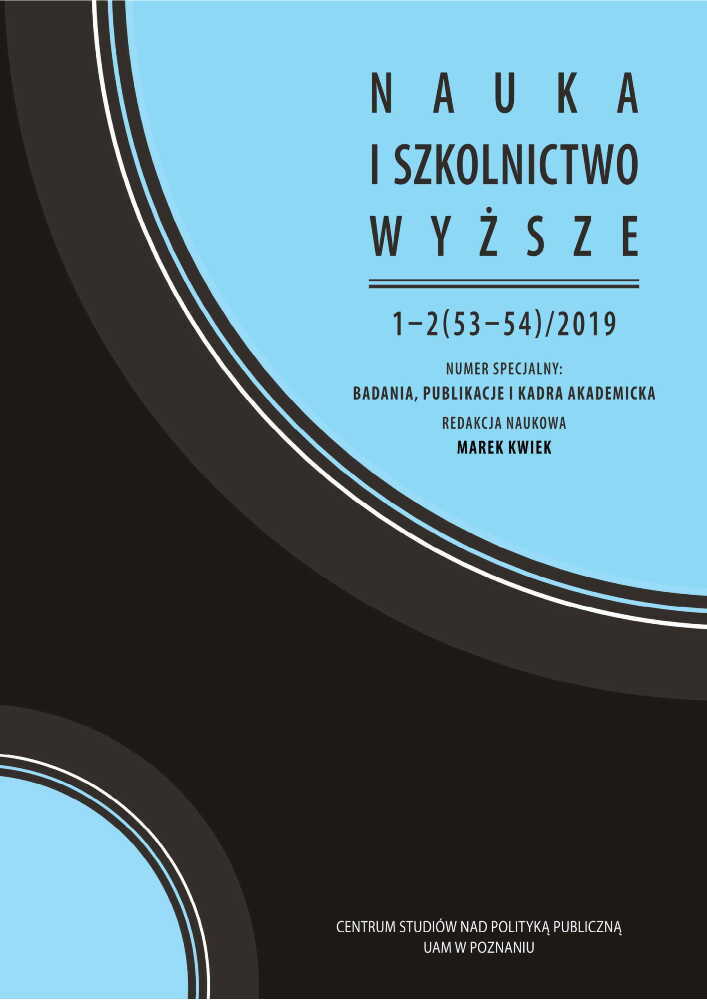Abstrakt
Współpraca w nauce jest względnie dobrze opisywana na poziomie makro dzięki ilościowym analizom dużych baz bibliograficznych. Takie ujęcie współpracy naukowej ma jednak szereg znanych ograniczeń. Stoimy na stanowisku, że, aby poszerzyć wiedzę o procesach społecznych w świecie nauki, konieczne jest bardziej pogłębione ujęcie, które (1) rozróżnia różne typy aktorów społecznych identyfikowanych przez naukowców jako potencjalni współpracownicy, (2) identyfikuje cechy relacji współpracy, które potencjalni współpracownicy postrzegają jako istotne, (3) jakimi strukturami sieci relacji współpracy otoczeni są naukowcy i jakie czynniki odpowiadają za zróżnicowanie tych struktur. Za pomocą 30 wywiadów pogłębionych (IDI) przeprowadzonych z polskimi naukowcami zebraliśmy szczegółowe informacje na temat poszczególnych współpracy, które pozwoliły nam na analizę relacji z indywidualnych perspektyw i rozrysowanie ego-centrycznych sieci współpracy poszczególnych respondentów. Wśród swoich współpracowników naukowcy wymieniają zarówno osoby, jak i zespoły lub całe instytucje. Rozróżniają również współprace symetryczne i niesymetryczne. Struktury ego-centrycznych sieci współpracy są zróżnicowane ze względu na (a) strategie przywódcze kierowników zespołów, szczególnie pod względem tego, czy zespoły są budowane wokół ludzi, czy też raczej wokół pozycji; (b) ulokowanie instytucjonalne poprzez łatwość bądź trudność nawiązywania współpracy z naukowcami z większych ośrodków; (c) stopień naukowy i zmiany w zasadach finansowania, albowiem grant badawczy dla „młodego naukowca” pozwala mu na więcej swobody i oderwanie od lokalnych hierarchii organizacyjnych.
Finansowanie
Wydanie tego tomu nie byłoby możliwe bez wsparcia otrzymanego w ramach projektu MNISW Dialog (0022/DLG/2019/10), za co redaktor wyraża podziękowanie.
Bibliografia
Baldwin, R.E. i Forslid, R. (2000). The core-periphery model and endogenous growth: Stabilizing and destabilizing integration. Economica 67: 307–324.
Beaver, D. DeB (2001). Reflections on scientific collaboration (and its study): Past, present, and future. Scientometrics 52: 365–377.
Birnbaum, R. i Edelson, P.J. (1989). How colleges work: The cybernetics of academic organization and leadership. The Journal of Continuing Higher Education 37: 27–29.
Blau, P.M. (1994). The organization of academic work. Transaction Publishers.
Boyer, E.L. (1997). Scholarship reconsidered: Priorities of the professoriate. Jossey-Bass.
Cohen, M.D. i March, J.G. (1974). Leadership and ambiguity: The american college president. ERIC.
Coleman, J.S. (1990). Foundations of social science theory. Cambridge, MA: Belknap Press.
Crosland, M. (1975). The development of a professional career in science in France. Minerva 13: 38–57.
Csardi, G. i Nepusz, T. (2006). The igraph software package for complex network research. InterJournal Complex Systems: 1695.
DeSolla P.D. (1965). Networks of scientific papers. Science 149: 510–515.
Han, Shin-Kap. (2003). Tribal regimes in academia: A comparative analysis of market structure across disciplines. Social networks 25: 251–280.
Hedström, P. (2005). Dissecting the social on the principles of analytical sociology. Cambridge University Press.
Hermanowicz, J.C. (1998). The presentation of occupational self in science. Qualitative Sociology 21: 129–148.
Kapferer, B. (1969). Norms and the manipulation of relationships in a work context. Edited by J.C. Mitchell. Manchester: Manchester University Press.
Katz, J.S. i Martin, B.R. (1997). What is research collaboration? Research policy 26: 1–18.
Kuwabara, K., Luo, J. i Sheldon, O. (2010). Multiplex exchange relations. Advances in Group Processes 27: 239–268.
Kwiek, M. (2015). Uniwersytet w dobie przemian: Instytucje i kadra akademicka w warunkach rosnącej konkurencji. Warszawa: PWN.
Lepori, B., Barberio, V., Seeber, M. i Aguillo, I. (2013). Core–periphery structures in national higher education systems. a cross-country analysis using interlinking data. Journalof Informetrics 7: 622–634.
Lewis, J.M., Ross, S. i Holden, T. (2012). The how and why of academic collaboration: Disciplinary differences and policy implications. Higher Education 64: 693–708.
Leydesdorff, L. i Wagner, C.S. (2008). International collaboration in science and the formation of a core group. Journal of Informetrics 2: 317–325.
Lorrain, F. i White, H.C. (1971). Structural equivalence of individuals in social networks. Journal of Mathematical Sociology 1: 49–80.
Middlehurst, R. i Elton, L. (1992). Leadership and management in higher education. Studies in Higher Education 17: 251–264.
R Core Team (2015). R: A language and environment for statistical computing. Vienna, Austria: R Foundation for Statistical Computing.
Schneijderberg, Ch. i Merkator, N. (2013). The new higher education professionals. W: The academic profession in europe: New tasks and new challenges, 53–92. Springer.
Slaughter, S. i Leslie, L.L. (1997). Academic capitalism: Politics, policies, and the entrepreneurial university. ERIC.
Sonnenwald, D.H. (2007). Scientific collaboration. Annual review of information science and technology 41: 643–681.
Subramanyam, K. (1983). Bibliometric studies of research collaboration: A review. Journal of Information Science 6: 33–38.
Whitley, R. (2000). The intellectual and social organization of the sciences. Oxford University Press.
Whitley, R. (2003). Competition and pluralism in the public sciences: The impact of institutional frameworks on the organisation of academic science. Research Policy 32: 1015–1029.
